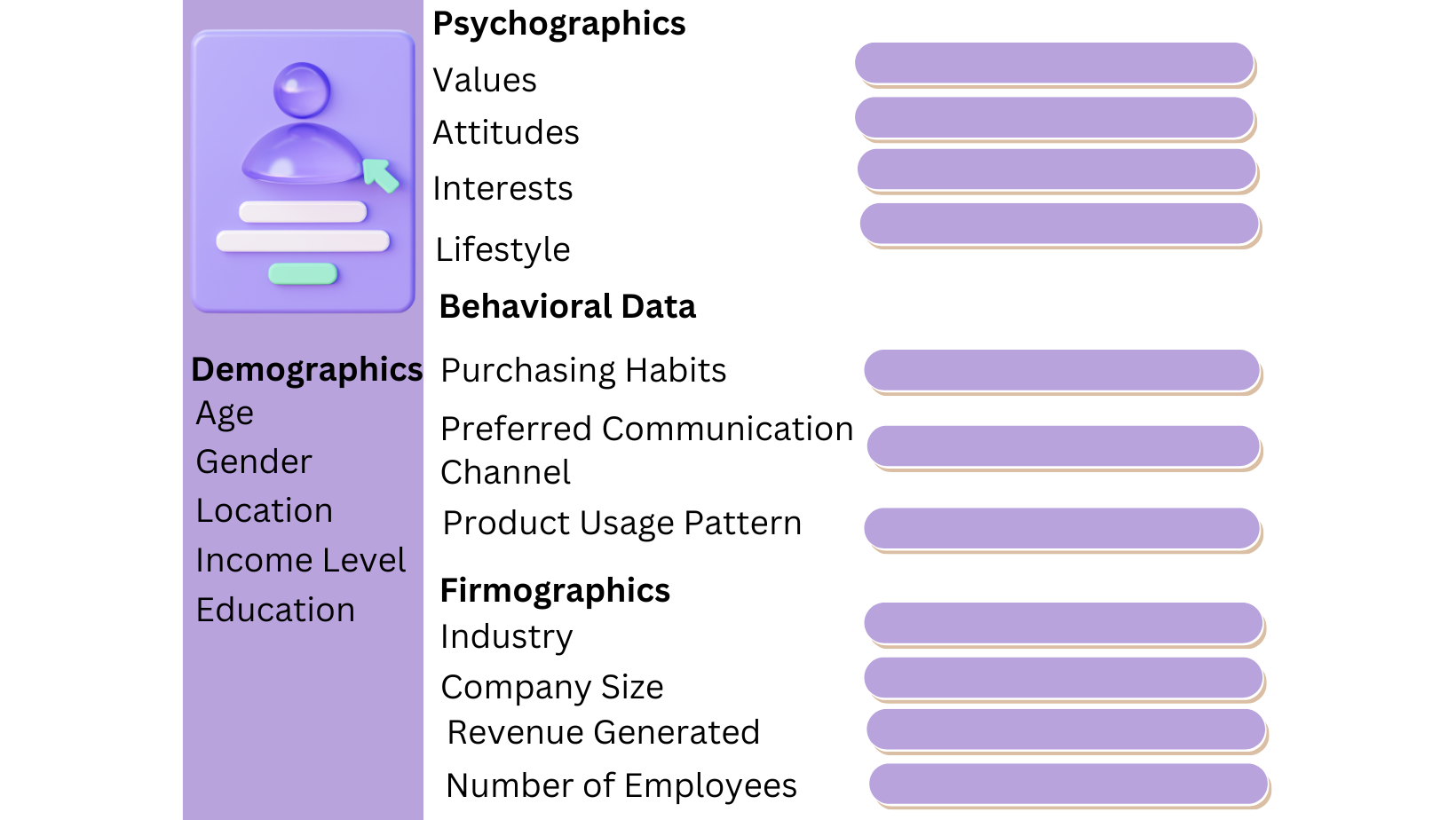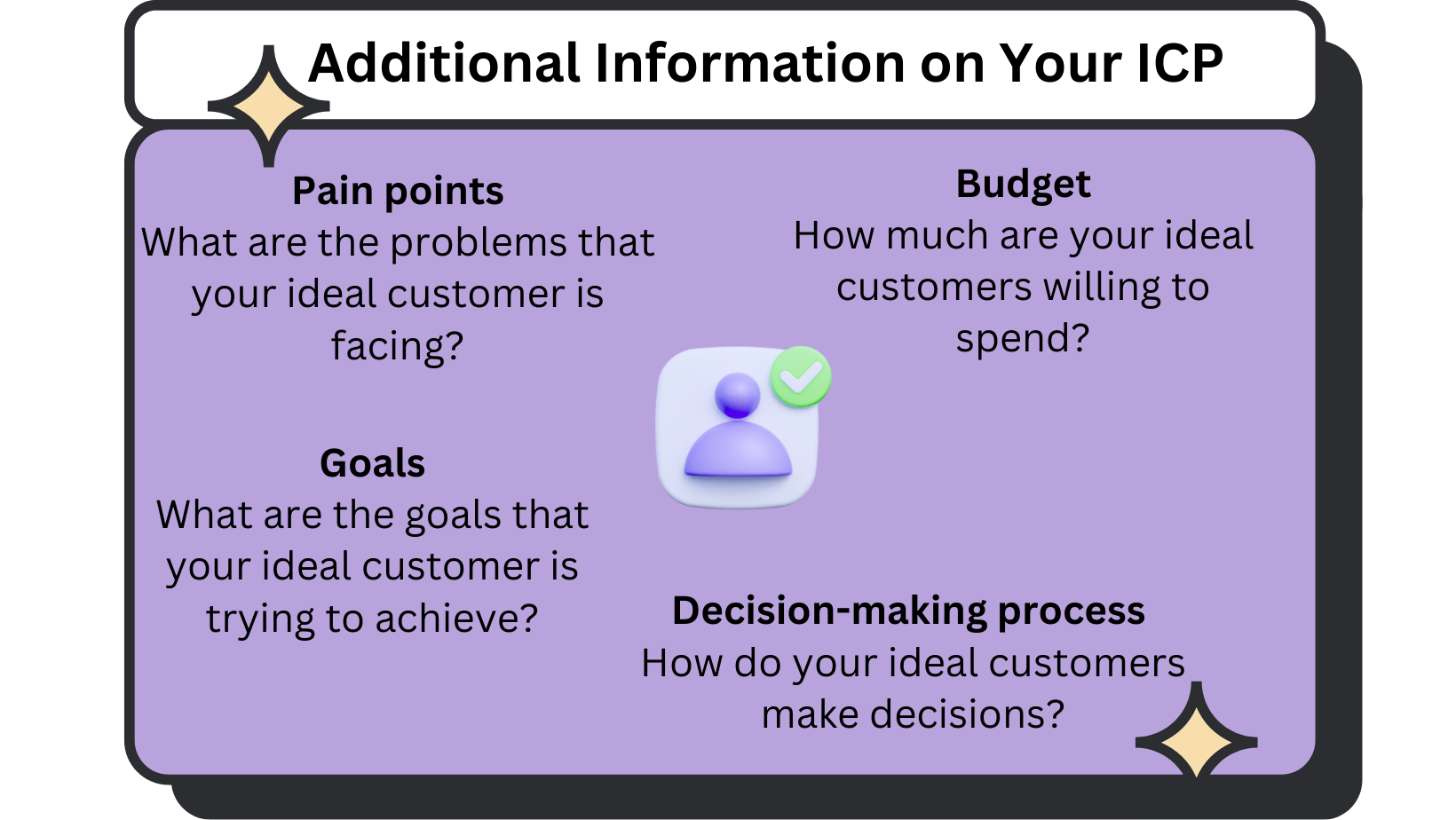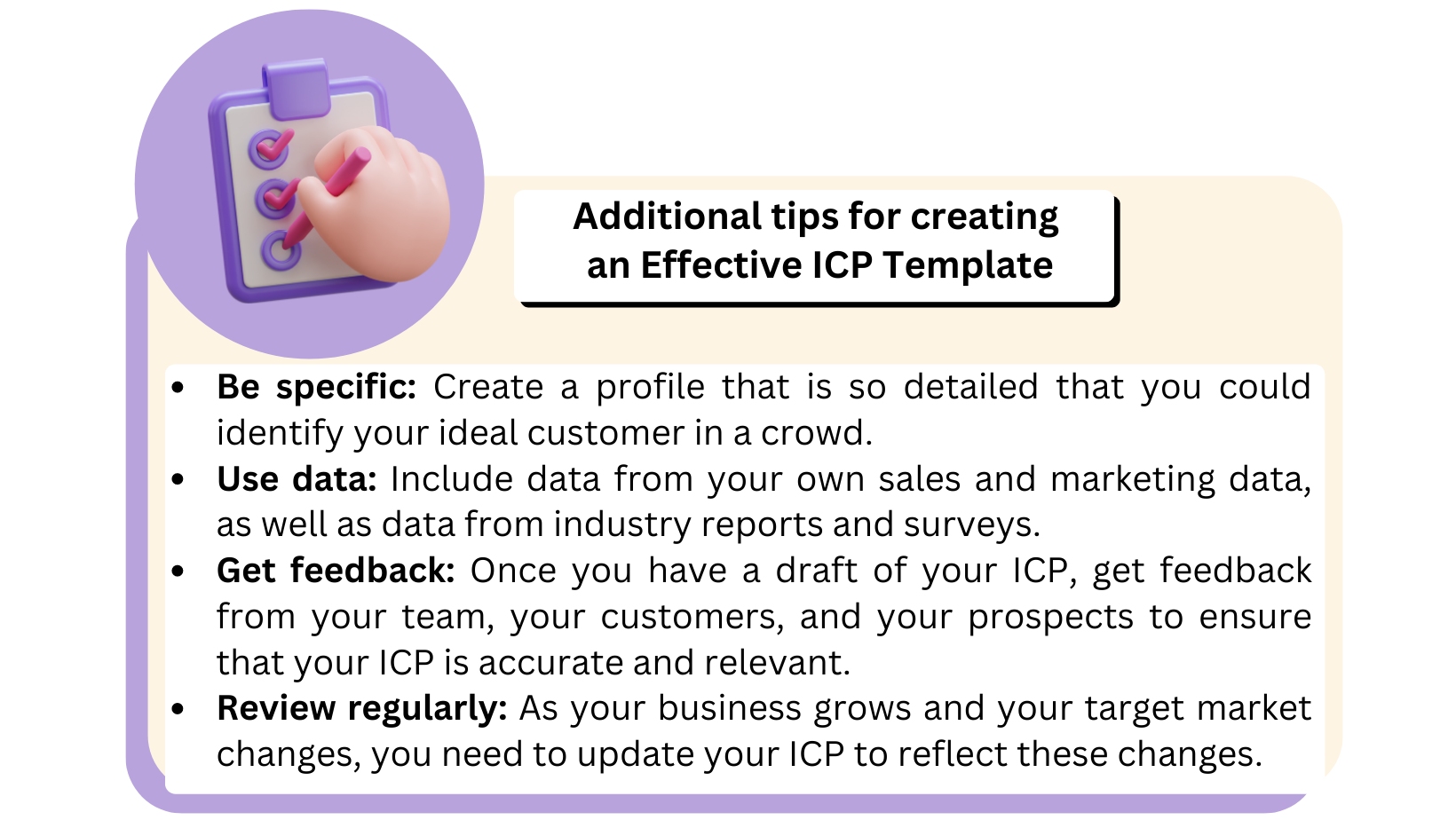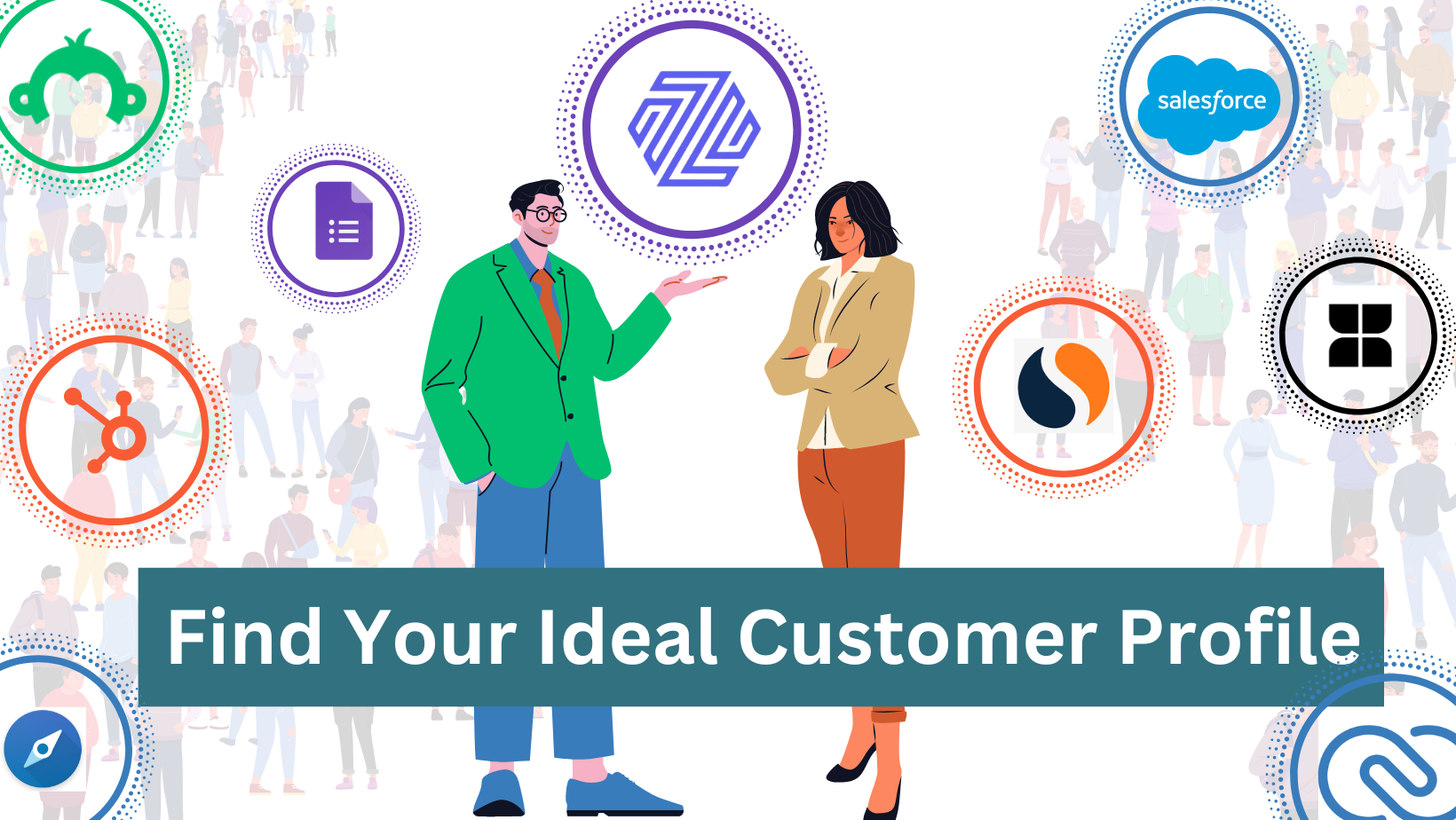Defining your ideal customer profile (ICP) is crucial for success in the B2B space.
Before we answer “How to find your Ideal Customer Profile?”, let’s answer “What is an Ideal Customer Profile?” and “Why do you need it?”
What is an Ideal Customer Profile (ICP)?
Your ICP is the key to unlocking B2B opportunities. It helps you identify the specific industries, company sizes, and decision-making roles that align with your solutions.
Imagine your ICP as a finely tuned blueprint, a strategic roadmap that leads you directly to clients who are the appropriate fit for your B2B business. It is similar to having a compass that points you in the direction of success.
Why do you need an ICP?
With a well-defined ICP, you gain a competitive edge. With more effective resource allocation, you can focus on acquiring and nurturing clients with the highest potential for long-term success and profitability. It also helps you identify opportunities for upselling or cross-selling within your existing client base.
Remember, a well-crafted ICP is your compass in the vast B2B landscape, pointing you toward the most promising business opportunities. By leveraging its power, you can navigate the B2B world with precision and purpose.
How to find your ICP?
1. Understand Your Product or Service:
Before you can identify your ideal customer profile, it’s important to have a deep understanding of your product or service.
-What pain points does it solve?
-What unique value does it offer?
By answering these questions, you’ll gain valuable insights into the type of customers who would benefit most from what you have to offer.
2. Analyze Your Existing Customer Base:
Your existing customer base is a goldmine of information when it comes to finding your ideal customer profile. Analyze your current customers and look for common characteristics among your most valuable and satisfied clients, such as industry, company size, revenue, demographics, interests, buying behaviors, and preferences.
This analysis will help you create a baseline for your ideal customer profile and serve as a starting point for further research.
ps: Read Prospecting Meaning and How to do it? and Prospect Awareness: The Key to Unlocking Successful Prospecting.
3. Conduct Market Research:
Thorough market research is essential to understanding your target audience. Study industry reports competitor analysis, and market trends. Identify gaps in the market where your product or service can offer unique value. Look for market segments with high growth potential and a clear need for your offering.
Must read: Market penetration strategies for start-ups to understand and implement strategies using the data from market research.
4. Define Your Value Proposition:
Craft a compelling value proposition that addresses the pain points of your target audience. Highlight how your product or service solves their problems or fulfills their needs better than competitors. A strong and personalized value proposition will attract your ideal customers and set you apart from the competition.
5. Utilize Social Media Listening:
Social media platforms are rich sources of customer insights. Monitor conversations, comments, and mentions related to your industry, products, or services. Pay attention to the needs, challenges, and preferences expressed by users. This social media listening will help you identify trends, understand customer pain points, and refine your ideal customer profile accordingly.
Use this data to personalize your outreach. For effective email deliverability strategies, read the article: Email Deliverability: A Step-by-Step Guide
6. Leverage Data and Analytics:
Utilize data and analytics tools to gain deeper insights into your target audience. Leverage website analytics, customer surveys, social media analytics, and CRM data to understand customer behavior, preferences, and engagement patterns. This data-driven approach will help refine your ICP further.
7. Analyze Competitor Strategies:
Examine your competitors’ customer profiles and strategies to gain further insights into your target audience. Identify overlaps and differences between your ideal customer profiles to refine your own understanding. By understanding how your competitors attract and serve their customers, you can uncover new opportunities and differentiate yourself in the market.
8. Seek Feedback from Sales and Customer Support Teams:
Your sales and customer support teams interact directly with customers. They possess valuable knowledge about their pain points, motivations, and objections. Regularly gather feedback from these teams to gain a holistic understanding of your ideal customer. Incorporate their insights into your ICP.
9. Create Buyer Personas:
Develop detailed buyer personas based on the insights gathered. These personas represent your ideal customers and provide a clear picture of their characteristics, goals, challenges, and preferences. Include demographic information, job titles, responsibilities, and common objections. This will guide your marketing strategies.
10. Refine and Test:
The process of identifying your ICP is not a one-time task. Continuously refine and iterate your ideal customer profile as your business evolves and market dynamics change. Regularly analyze data, gather feedback, and adapt your strategies to ensure they align with your target audience.
What is the difference between Ideal Customer Profile(ICP) and Buyer Persona?
ICP and buyer persona are both terms used in marketing and sales, but they represent different concepts. Here’s an explanation of each:
Ideal Customer Profile (ICP):
The Ideal Customer Profile refers to a description of the ideal type of customer or organization that a business wants to target and serve. It involves identifying the characteristics, attributes, and specific criteria that make a customer an ideal fit for a company’s products or services.
The ICP typically takes into account factors such as industry, company size, geographic location, demographics, psychographics, purchasing behavior, and other relevant characteristics.
And as stated earlier, the ICP helps businesses focus their marketing and sales efforts on the most promising and profitable customer segments, enabling more efficient targeting and higher conversion rates.
Buyer Persona:
A buyer persona, also known as a customer persona, is a fictional representation of an ideal customer based on market research and data analysis. It involves creating a detailed profile that represents a specific segment of customers who share similar characteristics, needs, motivations, and behaviors.
A buyer persona typically includes information such as demographic data, job titles, responsibilities, goals, challenges, preferences, and decision-making processes. Creating buyer personas helps businesses understand their customers better and tailor their marketing strategies, messaging, and product offerings to address the specific needs and preferences of different customer segments.
In a nutshell, the key difference between ICP and buyer persona is that ICP focuses on identifying the ideal customer profile based on overall characteristics, while buyer personas delve deeper into understanding individual customer segments, their motivations, and behaviors. ICP defines the broad criteria for target customers, while buyer personas provide more specific insights for personalized marketing and sales approaches.
Ideal Customer Profile (ICP) Template
An ICP template is a document that helps you define the characteristics of your ideal customer. It includes information about their demographics, firmographics, psychographics, and behavioral data.
Here is an example template for you

Some additional information and tips:


Tools to streamline the process?
In today’s increasingly complex sales and marketing landscape, time is of the essence. To navigate this intricate environment efficiently, businesses must utilize a range of interconnected tools. These include sales intelligence tools, customer relationship management (CRM) software, survey software, and customer profile software.
By leveraging these tools in tandem, companies can streamline their processes, simplify data collection, and expedite the acquisition of verified customer information. Such an integrated approach empowers organizations to optimize their operations, enhance decision-making, and ultimately drive greater success in the ever-evolving business landscape.
Here are some famous tools and their key points:
Sales Intelligence Tools:
i. LinkedIn Sales Navigator - a tool that provides sales professionals with access to advanced search filters, lead recommendations, and real-time updates on target accounts and prospects.
ii. Zintlr - a platform that provides sales intelligence data on millions of companies and individuals. Zintlr also has an extension that helps predict and verify email IDs and write cold emails through smart suggestions.
iii. SimilarWeb- a website analytics tool that can provide insights into your prospects’ website traffic, including top pages, referral sources, and audience demographics.
These are just a few of the many sales intelligence tools, you can choose them depending on your budget and market requirements.
Customer Relationship Management (CRM) Software:
i. Salesforce: Salesforce is the most popular CRM software in the world. It is a powerful and scalable platform that can be used by businesses of all sizes. Salesforce offers a wide range of features, including contact management, lead tracking, sales forecasting, and customer support.
ii. Zoho CRM: Zoho CRM is a cloud-based CRM software that is known for its affordability and ease of use. Zoho CRM offers a wide range of features, including contact management, lead tracking, sales forecasting, and customer support.
iii. HubSpot CRM: HubSpot CRM is a freemium CRM software that is known for its marketing and sales automation features. HubSpot CRM offers a wide range of features, including contact management, lead tracking, sales forecasting, and marketing automation.
These are just a few of the many CRM software available on the market. The best CRM software for your business will depend on your specific needs and requirements
Survey Software:
i. Qualtrics CoreXM: Qualtrics is a leading survey software company that offers a wide range of features, including advanced analytics, customization, and integrations. Qualtrics is used by some of the world’s largest companies, such as Amazon, Google, and Microsoft.
ii. SurveyMonkey: SurveyMonkey is a popular survey software that is known for its ease of use and affordability. SurveyMonkey offers a wide range of features, including templates, question types, and analysis tools. SurveyMonkey is used by businesses of all sizes, from small businesses to large enterprises.
iii. Google Forms: Google Forms is a free survey software that is integrated with Google Workspace. Google Forms offers a basic set of features, but it is a good option for businesses that are looking for a simple and affordable survey solution.
These are just a few of the many survey software solutions that are available on the market. The best survey software for your business will depend on your specific needs and requirements.
Customer Profile Software:
i. Make My Persona: A complimentary tool presented by HubSpot, designed to facilitate the creation of comprehensive customer profiles. Empowering your entire organization to enhance marketing, sales, and customer service efforts, this user-friendly tool offers an intuitive drag-and-drop interface. With customizable templates and helpful examples, Make My Persona streamlines the process, ensuring your business maximizes its effectiveness in connecting with the right customers.
ii. Persona Bold: The ultimate customer profile software for interactive online avatars. With its highly customizable features, detailed reports and analytics, and seamless integrations with other marketing tools, PersonaBold revolutionizes the way organizations understand their audience. Enhancing sales and marketing initiatives, this powerful tool enables businesses to create engaging and interactive online avatars that provide a deeper understanding of customers.
iii. Xtensio: The collaborative workspace, provides users with a highly customizable platform to create ever-evolving documents. With a plethora of persona templates and examples, it empowers sales and marketing professionals to craft rich and detailed buyer personas and ideal customer profiles. Furthermore, Xtensio offers detailed reports and analytics to gather valuable insights, while its seamless integrations with other marketing tools enhance productivity and efficiency
Ultimately, the best customer profile software for your business will depend on your specific needs and requirements.
Conclusion:
Identifying your ideal customer profile is a critical step in optimizing your marketing efforts and achieving sustainable business growth. By:
- understanding your product,
- analyzing your customer base,
- conducting market research,
- defining your value proposition
- leveraging social media listening
- analyzing competitor strategies
- leveraging data and website analytics
- seeking feedback from sales and customer support teams
- creating buyer personas
- refining and testing you can develop an ICP.
Bear in mind, this process is dynamic, and as your business evolves, so too should your ideal customer profile. Regularly revisit and refine your customer persona to stay relevant and continue attracting and serving your ideal customers effectively.
Remember, understanding your customers is the key to success in the B2B space!

